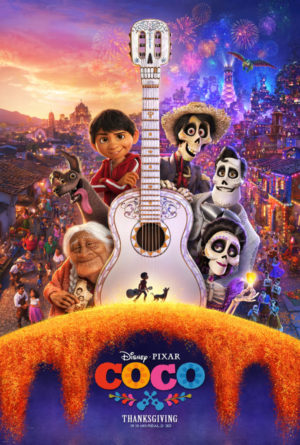 During opening weekend, I took my daughter to see the new Disney/Pixar movie, Coco. It’s a movie she’s been looking forward to seeing for almost a year, since the trailers for the new movie came out quite some time ago. I didn’t have much expectations for the movie, as I figured it would be similar to a previous animated film, Book of Life, another film centered around Día de los Muertos, or the Day of the Dead. But the movie is completely different, and definitely worth a viewing. As I watched the film Coco with my 12 year old, I began to realize that many of the practices and beliefs that were being practiced by the Mexican families were similar if not identical to many practices that we performed for my deceased ancestors as a Chinese/Taiwanese immigrant family in the United States.
During opening weekend, I took my daughter to see the new Disney/Pixar movie, Coco. It’s a movie she’s been looking forward to seeing for almost a year, since the trailers for the new movie came out quite some time ago. I didn’t have much expectations for the movie, as I figured it would be similar to a previous animated film, Book of Life, another film centered around Día de los Muertos, or the Day of the Dead. But the movie is completely different, and definitely worth a viewing. As I watched the film Coco with my 12 year old, I began to realize that many of the practices and beliefs that were being practiced by the Mexican families were similar if not identical to many practices that we performed for my deceased ancestors as a Chinese/Taiwanese immigrant family in the United States.
Before I make the comparisons, I’ll remind readers that discussing the dead, or customs and practices around death is generally considered taboo in Chinese culture. But I have previously broken this taboo by writing about Chinese funerary customs, so I’ll wander again into dangerous waters. If you’re from a Chinese family, you might want to refrain from talking about this topic with the elders in your family. In fact ghosts and the supernatural are generally still considered forbidden topics in mainland China, and it was a surprise that Coco made it past Chinese censors without any edits.
One of the major Chinese holidays is also known as 盂蘭節 or Ghost Festival. The holiday is sometimes called Chinese Halloween, and is very similar to the Mexican Day of the Dead. I remember when I was growing up, that my mom would set up an altar on major Chinese holidays, like the Ghost Festival, and the center of the altar would have the photographs of the deceased ancestors. We would burn incense, and joss paper and lay out food offerings, typically oranges and cooked rice with other dishes for the deceased, so they would have food and money in the afterlife. We would eat the food it had been left out for a long time, long enough for the deceased to partake their portion of the food. It’s common for Chinese to burn paper replicas of cars, boats, houses, etc. for the deceased to have these things in the afterlife.
Similarly on the Day of the Dead, in Coco, there’s a strong importance to having the photograph of the family ancestor placed in the family ofrenda. The belief in Coco, is that if your photograph is not in the family ofrenda, you won’t be able to pass over on the Day of the Dead to visit your relatives. You’re essentially forgotten. In Coco, if you’re forgotten, your spirit will disappear from the afterlife and cease to exist when the last person who remembers you dies in the real world.
Similar to Chinese culture, the Mexicans lay out food for the deceased, so they’ll have food in the afterlife. The amount of food the deceased have in the afterlife varies by how much they were remembered and offered food in the real world. So a popular singer, like the character Ernesto de la Cruz in the movie Coco, had an abundance of food in the afterlife from all his devoted living fans, while Hector, who was forgotten had none.
By the end of the movie, these similarities between the two cultures got me wondering if they arose from the same source. My guess is yes, since at the end of the movie Coco, there was a disclaimer saying the beliefs around the Day of the Dead, had roots in Mexican and indigenous peoples. And with the knowledge that indigenous peoples traveled from Asia to settle in the Americas, I think we’re fairly safe in assuming these beliefs have a common beginning.
In case you haven’t seen Coco yet, won’t spoil any more of the movie for you, but I will say it’s one of the best kids movies I’ve seen in a while, and well worth the price of admission.








